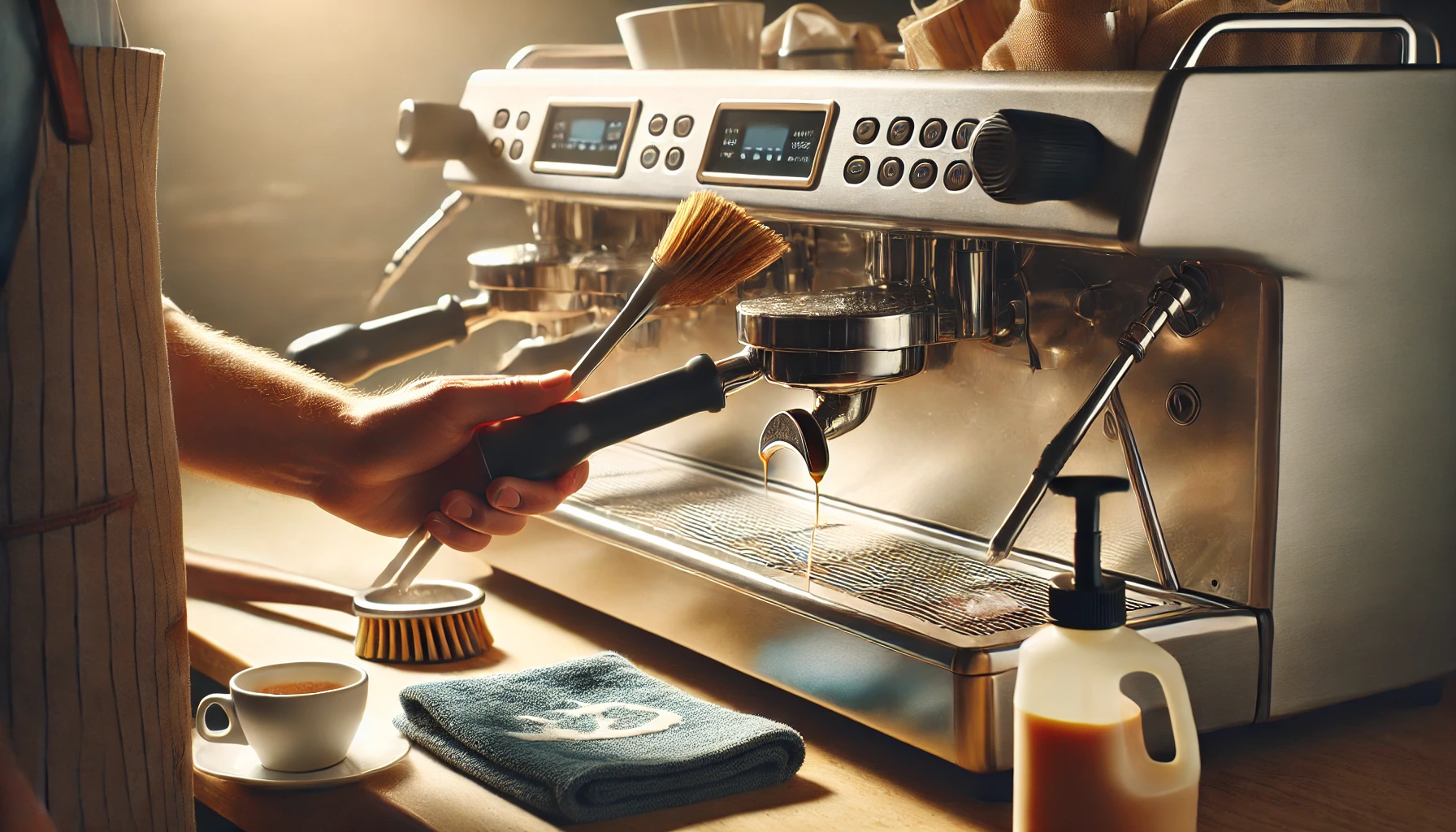If you love coffee, How to Clean Your Espresso Machine is probably one of the most important appliances in your kitchen. But let’s be honest—when was the last time you gave it a deep clean?
Cleaning your espresso machine isn’t just about keeping it looking nice; it directly affects the taste of your coffee. Old coffee oils, leftover milk residue, and mineral buildup can ruin the flavor of your espresso, leaving it bitter or even sour. Worse yet, a dirty machine can break down faster, leading to expensive repairs.
If you’ve ever wondered, “How often should I clean my espresso machine?” or “What’s the best way to descale it?”, you’re in the right place. In this guide, we’ll walk you through the daily, weekly, and monthly maintenance your machine needs. Whether it’s a fancy home espresso maker or a high-end café model.
Understanding Your Espresso Machine: What Needs Cleaning?
Before we dive into cleaning techniques, let’s take a quick look at the key parts of an espresso machine that need regular maintenance:
1. The Portafilter & Basket
This is where you place your ground coffee. Over time, coffee oils and tiny particles build up in the basket, affecting the taste of your espresso. If not cleaned properly, it can also lead to blockages.
2. The Group Head & Shower Screen
The group head is where hot water is forced through the coffee grounds. The shower screen distributes the water evenly. If this area isn’t cleaned, it can clog, causing uneven extraction and a weaker espresso.
3. The Steam Wand
If you love lattes and cappuccinos, you use the steam wand a lot. But milk residue can quickly build up inside, leading to bacteria growth and affecting the froth quality. A neglected steam wand can also get clogged, making it impossible to steam milk properly.
4. The Drip Tray & Waste Bin
Used coffee grounds and excess water collect here. A dirty drip tray can become a breeding ground for mold and bacteria, leading to unpleasant smells and potential health risks.
5. The Water Tank & Boiler
Over time, minerals from water accumulate inside the boiler, leading to scale buildup. If left unchecked, this can reduce the efficiency of your machine and even cause permanent damage.
Now that you know which parts need attention, let’s get into the cleaning routine!
Daily Cleaning Routine: Quick Maintenance for Better Espresso
You don’t need to spend hours cleaning your espresso machine every day, but a little maintenance after each use can go a long way. Here’s what you should do:
1. Flush the Group Head
After pulling a shot of espresso, run water through the group head for a few seconds. This helps remove leftover coffee grounds and oils.
2. Wipe and Purge the Steam Wand
Right after steaming milk, wipe the steam wand with a damp cloth and purge it by releasing some steam for a couple of seconds. This prevents milk from drying inside and clogging the nozzle.
3. Empty & Rinse the Portafilter
Knock out the used coffee puck, then rinse the portafilter and basket under hot water. If you leave old coffee residue in there, it can make your next espresso taste bitter.
4. Clean the Drip Tray & Waste Bin
Dump out any water and used coffee grounds. A quick rinse will prevent buildup and keep everything smelling fresh.
This daily routine only takes a few minutes but keeps your espresso machine running smoothly and your coffee tasting great.
Weekly Deep Cleaning: Keeping Your Machine in Top Shape
Once a week, your espresso machine needs a little extra love. This is when you should do a more thorough cleaning to remove hidden coffee residues and milk buildup.
1. Backflushing with Cleaning Tablets (For machines with a three-way solenoid valve)
- Insert a blind basket (a filter basket with no holes) into the portafilter.
- Add an espresso machine cleaning tablet or powder.
- Lock the portafilter into the group head and start the brewing cycle for 10 seconds, then stop.
- Repeat this process 4-5 times, then rinse thoroughly with water.
Backflushing removes old coffee oils and residue inside the machine that daily flushing doesn’t reach.
2. Scrubbing the Group Head & Shower Screen
Use a group head cleaning brush to scrub away coffee particles stuck in the shower screen and gasket. This prevents blockages and ensures even water flow.
3. Deep Cleaning the Steam Wand
If milk residue has built up, soak the steam wand in a milk cleaner solution for a few minutes, then scrub it with a small brush to remove any stubborn buildup.
4. Washing the Portafilter & Basket Thoroughly
Soak these parts in a cleaning solution to break down old coffee oils and prevent bitter flavors from developing.
By doing this deep cleaning once a week, you’ll prevent major issues and keep your espresso shots tasting fresh.
See more: Top 10 Best Espresso Machines for Home Use: Brew Like a Barista
Monthly Maintenance: Deep Cleaning & Descaling Your Espresso Machine
Even with daily and weekly cleaning, minerals from water, coffee oils, and milk residue will still build up over time. That’s why a monthly deep clean and descaling process is essential.
Skipping this step can lead to clogged pipes, poor water flow, and even mechanical failure. Worse yet, if scale builds up inside the boiler, your machine may struggle to heat water properly, affecting the flavor and consistency of your espresso.
Let’s break down what needs to be done each month to keep your machine in peak condition.
1. Descaling Your Espresso Machine
(Removes mineral buildup in the boiler and internal pipes)
If you live in an area with hard water, your machine will develop calcium and limescale deposits over time. These deposits can clog your boiler and affect the taste of your espresso. Descaling dissolves these minerals and prevents costly repairs.
How to Clean Your Espresso Machine: Step-by-Step Guide
What you’ll need:
- A commercial descaling solution or DIY mix (white vinegar or citric acid + water)
- Fresh water
- A large container for runoff
Instructions:
- Prepare the solution – If using a commercial descaler, follow the package instructions. If making your own, mix equal parts white vinegar and water or dissolve 2 tablespoons of citric acid in 1 liter of water.
- Fill the water reservoir with the solution.
- Run the descaling cycle – Brew water (without coffee) through the machine as if making espresso. Do this until half the solution has passed through.
- Let it sit – Turn off the machine and let the solution sit inside for 15-20 minutes to break down scale buildup.
- Flush with clean water – Run fresh water through the system at least twice to remove any remaining descaler.
👉 Pro tip: If you taste or smell vinegar after descaling, run an extra flush cycle with fresh water!
2. Cleaning the Water Tank & Filter
Even if you use filtered water, your machine’s water reservoir can develop algae or mold if left unattended. If your espresso machine has a built-in water filter, it also needs to be changed regularly.
- Remove the water tank and scrub it with a brush and warm soapy water.
- If your machine has a replaceable water filter, check the manufacturer’s guidelines on when to change it (usually every 2-3 months).
3. Checking & Replacing Seals & Gaskets
The rubber gasket inside your espresso machine’s group head creates a tight seal between the portafilter and the machine. Over time, this gasket hardens, cracks, or becomes less effective, leading to leaks and poor espresso extraction.
To check if your gasket needs replacing:
- Remove the shower screen (located under the group head) and inspect the rubber seal.
- If it looks worn, brittle, or cracked, it’s time for a replacement.
Bonus tip: If your machine leaks when brewing, the gasket might be the issue!
Troubleshooting Common Espresso Machine Cleaning Issues
Even if you clean your machine regularly, you might still run into issues. Here’s how to fix them:
1. Espresso Tastes Bitter or Burnt
🔹 Possible cause: Old coffee oils in the portafilter or group head.
✅ Fix: Soak the portafilter and filter basket in a cleaning solution overnight, then rinse thoroughly.
2. Weak or Sour Espresso
🔹 Possible cause: Dirty shower screen or clogged group head.
✅ Fix: Use a group head brush to scrub the shower screen and backflush the machine with a cleaning solution.
3. Steam Wand is Clogged or Weak
🔹 Possible cause: Milk residue blocking the wand.
✅ Fix: Use a thin pin or steam wand cleaning brush to unclog the hole. Soak the wand in a milk cleaner solution for deep cleaning.
4. Espresso Machine is Taking Longer to Brew
🔹 Possible cause: Limescale buildup inside the boiler.
✅ Fix: Run a descaling cycle to remove calcium deposits.
Pro Tips for Keeping Your Espresso Machine in Top Condition
✅ Use filtered water – Hard water causes faster mineral buildup. Using filtered or bottled water can extend the life of your machine and keep your espresso tasting better.
✅ Keep a cleaning schedule – Make a habit of daily, weekly, and monthly cleanings. A small effort now prevents major problems later.
✅ Invest in quality cleaning tools – A group head brush, steam wand cleaner, and descaling solution can make the process easier and more effective.
✅ Always purge the steam wand – After steaming milk, always blast steam for a few seconds to clear out residue. This prevents clogs and bacterial growth.
✅ Change gaskets and filters regularly – If your espresso shots start tasting different or your machine leaks, worn-out parts might be to blame.
Final Thoughts: Cleaning = Better Espresso & Longer Machine Life
Cleaning your espresso machine isn’t just a chore—it’s an investment in better coffee, smoother performance, and a longer-lasting machine.
By following this step-by-step maintenance guide, you’ll never have to deal with bitter espresso, weak shots, or broken-down equipment again.
I’m Jeff Olson, and I love coffee. In fact, I’m something of a professional about coffee. I own and operate coffeemachinenes.com, one of the web’s top resources for everything coffee-related. I’m also an avid home barista, and enjoy experimenting with different brewing methods and flavor profiles. When I’m not nerding out about all things coffee, you can find me playing guitar or spending time with my wife and kids.

